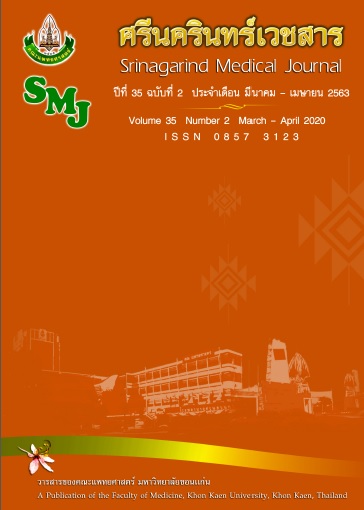Effect of Paraquat on Interferon-gamma Production by T cell
Keywords:
พาราควอต, อินเตอร์ฟีรอน-แกมมา, Paraquat, T cell, Interferon-gammaAbstract
ผลของพาราควอตต่อการสร้างอินเตอร์ฟีรอน-แกมมาโดยทีเซลล์
สุรชาติ พุทธิษา1*, พัชราภรณ์ ทิพยวัฒน์2, รุ่งนภา ศรานุชิต3, นัฐพล ประกอบแก้ว4
1 หน่วยความเป็นเลิศด้านภูมิคุ้มกันวินิจฉัยและรักษาในระดับเซลล์และโมเลกุล ภาควิชาเทคนิคการแพทย์ คณะสหเวชศาสตร์ มหาวิทยาลัยพะเยา
2 ภาควิชาเทคนิคการแพทย์ คณะเทคนิคการแพทย์ มหาวิทยาลัยขอนแก่น
3 วิทยาลัยการแพทย์แผนไทย มหาวิทยาลัยเทคโนโลยีราชมงคลธัญบุรี
4 ภาควิชาเทคนิคการแพทย์ คณะสหเวชศาสตร์ มหาวิทยาลัยบูรพา
หลักการและวัตถุประสงค์: พาราควอตเป็นสารเคมีกำจัดวัชพืชที่นิยมใช้กันอย่างแพร่หลายทั่วโลก และมีรายงานถึงความเป็นพิษต่อระบบภูมิคุ้มกันในสัตว์ทดลอง แต่ยังไม่มีรายงานการศึกษาถึงผลกระทบต่อทีเซลล์มนุษย์ ดังนั้นการศึกษานี้จึงมีวัตถุประสงค์เพื่อศึกษาผลของพาราควอตต่อการสร้างไซโตไคน์อินเตอร์ฟีรอน-แกมมา (IFN-g) ของทีเซลล์มนุษย์ในหลอดทดลอง
วิธีการศึกษา: กระตุ้นเม็ดเลือดขาวชนิด peripheral blood mononuclear cells ในสภาวะที่มีพาราควอตความเข้มข้นต่างๆ ตรวจสอบความมีชีวิตของเซลล์โดยวิธี trypan blue exclusion และตรวจหา metabolic activity ด้วยวิธี MTT ตรวจวัดระดับ IFN-g โดยเทคนิค ELISA หลังจากกระตุ้นการทำงานของทีเซลล์ด้วย phytohemagglutinin
ผลการศึกษา: พาราควอตความเข้มข้น 100 µg/mL ไม่มีผลต่อความมีชีวิตของเซลล์ ในขณะที่ความเข้มข้น 300 µg/mL มีผลทำให้ร้อยละความมีชีวิตลดต่ำลงอย่างมีนัยสำคัญเมื่อเทียบกับสภาวะควบคุม (p< 0.05) และการตอบสนองของทีเซลล์โดยการสร้าง IFN-g เมื่อเพาะเลี้ยงร่วมกับพาราควอตทั้งสองความเข้มข้นมีค่าร้อยละของการยับยั้งการสร้าง IFN-g เพิ่มสูงขึ้นอย่างมีนัยสำคัญเมื่อเทียบกับสภาวะควบคุม (p< 0.05) นอกจากนี้พบว่าพาราควอตมีผลยับยั้งการทำงานของทีเซลล์ตั้งแต่ 24 ชั่วโมงแรกและการยับยั้งเพิ่มสูงขึ้นในอาสาสมัครทุกรายหลังสัมผัสกับพาราควอตเป็นเวลา 48 ชั่วโมง
สรุป: ผลการศึกษาบ่งชี้ว่าพาราควอตความเข้มข้น 100 และ 300 µg/mL มีฤทธิ์ยับยั้งการสร้าง IFN-g ของทีเซลล์ ซึ่งอาจนำไปสู่ความเสี่ยงต่อการเกิดโรคที่มีสาเหตุจากความไม่สมดุลของการตอบสนองของทีเซลล์ในผู้ที่ได้รับพาราควอตโดยตรงหรือการปนเปื้อนในสิ่งแวดล้อมและผลิตภัณฑ์ทางการเกษตรได้
Background and objective: Paraquat is one of the most widely used global herbicides for weed control. Recently, paraquat has been reported to have immune toxic effects in animal models, while effects on human T cell function remain undetermined. To resolve these issues, the effects of paraquat on IFN-g production by human T cells in vitro were evaluated.
Methods: Peripheral blood mononuclear cells were co-cultured with various concentrations of paraquat dichloride or phytohemagglutinin (PHA). Cell viability was determined by trypan blue exclusion and relative metabolic activity was assayed by MTT method. IFN-g production was measured after co-culture with phytohemagglutinin by ELISA.
Results: Paraquat at 100 µg/mL did not affect cell viability, whereas 300 µg/mL paraquat significantly reduced the percentage of viable cells compared with the control (p< 0.05). Addition of 100 and 300 µg/mL of paraquat significantly increased the percentage of IFN-g production inhibition compared with the control (p< 0.05). Moreover, inhibition of IFN-g production by paraquat was observed after 24 h co-culture and showed a robust effect in all individuals after 48 h co-culture.
Conclusion: Data indicated that paraquat at the concentration of 100 and 300 µg/mL had an inhibitory effect on IFN-g production by T cells. Thus, direct contact with paraquat or paraquat contaminated environments and agricultural products increased risk of diseases caused by T cell dysfunction.
References
Pataranawatab P, Kitkaewab D, Suppaudomab K. Paraquat Contaminations in the Chanthaburi River and vicinity areas, Chanthaburi province, Thailand. J Sci Technol Hum. 2012; 10: 17–24.
Amondham W, Parkpian P, Polprasert C, DeLaune R, Jugsujinda A. Paraquat adsorption, degradation, and remobilization in tropical soils of Thailand. J Environ Sci Heal - Part B Pestic Food Contam Agric Wastes. 2006; 41: 485–507.
Van Wendel De Joode BN, De Graaf IAM, Wesseling C, Kromhout H. Paraquat exposure of knapsack spray operators on banana plantations in Costa Rica. Int J Occup Environ Health. 1996;2:294–304.
Konthonbut P, Kongtip P, Nankongnab N, Tipayamongkholgul M, Yoosook W, Woskie S. Paraquat exposure of pregnant women and neonates in agricultural areas in Thailand. Int J Environ Res Public Health 2018; 15: 1–14.
Thai-PAN. ผลการเฝ้าระวังสารพิษตกค้าง ในผักผลไม้ ปี 2560. [สืบค้นเมื่อ 30 พฤศจิกายน 2562] Available from: http://www.thaipan.org/sites/default/files/file/pesticide_doc36.pdf
Suh GJ, Jeong S, Kwak YH, Shin S Do, Kim J. Effect of prohibiting the use of Paraquat on pesticide-associated mortality. BMC Public Health 2017; 17: 1–11.
Berry C, La Vecchia C, Nicotera P. Paraquat and Parkinson’s disease. Cell Death Differ 2010; 17: 1115-25.
Dinis-Oliveira RJ, Remião F, Carmo H, Duarte JA, Navarro AS, Bastos ML, et al. Paraquat exposure as an etiological factor of Parkinson’s disease. Neurotoxicology 2006; 27: 1110–22.
Wesseling C, Ahlbom A, Antich D, Rodriguez AC, Castro R. Cancer in banana plantation workers in Costa Rica. Int J Epidemiol 1996; 25: 1125–31.
Abbas AK, Lichtman AH, Pillai S; Cellular and Molecular Immunology. Philadelphia: Elsevier, 2014.
Jang YJ, Won JH, Back MJ, Fu Z, Jang JM, Ha HC, et al. Paraquat induces apoptosis through a mitochondria-dependent pathway in RAW264.7 cells. Biomol Ther 2015; 23: 407–13.
Fakhr A, Tabasi N, Mahmoudi M, Karimi G, Rafatpanah H, Riahi B, et al. Evaluation of suppressive effects of paraquat on innate immunity in Balb/c mice. J Immunotoxicol 2011; 8: 39–45.
Ahn KH, Ha HC, Lim JH, Won JH, Kim DK, Fu Z, et al. Paraquat reduces natural killer cell activity via metallothionein induction. J Immunotoxicol 2014; 12: 342–9.
Sengupta A, Manna K, Datta S, Das U, Biswas S, Chakrabarti N, et al. Herbicide exposure induces apoptosis, inflammation, immune modulation and suppression of cell survival mechanism in murine model. RSC Adv 2017; 7: 13957–70.
Bhat P, Leggatt G, Waterhouse N, Frazer IH. Interferon- derived from cytotoxic lymphocytes directly enhances their motility and cytotoxicity. Cell Death Dis 2017; 8: 1-11.
Ligocki AJ, Brown JR, Niederkorn JY. Role of interferon- and cytotoxic T lymphocytes in intraocular tumor rejection. J Leukoc Biol 2015; 99: 735–47.
Handgretinger R, Bauer J, Braumüller H, Schaller M, van den Broek M, Zender L, et al. T-helper-1-cell cytokines drive cancer into senescence. Nature 2013; 494(7437): 361–5.
Prihartono N, Kriebel D, Woskie S, Thetkhathuek A, Sripaung N, Padungtod C, et al. Risk of aplastic anemia and pesticide and other chemical exposures. Asia-Pacific J Public Heal 2011; 23: 369–77.
Bhardwaj N, Saxena RK. Elimination of young erythrocytes from blood circulation and altered erythropoietic patterns during paraquat induced anemic phase in mice. PLoS One 2014; 9: 1-11.
Ott M, Gogvadze V, Orrenius S, Zhivotovsky B. Mitochondria, oxidative stress and cell death. Apoptosis 2007; 12: 913–22.
Schieber M, Chandel NS. ROS function in redox signaling and oxidative stress. Curr Biol 2014; 24: 453–62.
Jena NR. DNA damage by reactive species: Mechanisms, mutation and repair. J Biosci 2012; 37: 503–17.
Holmström KM, Finkel T. Cellular mechanisms and physiological consequences of redox-dependent signalling. Nat Rev Mol Cell Biol 2014; 15: 411–21.
Franchi L, Byersdorfer CA, Glick GD, Tkachev V, Opipari AW, Ferrara JLM, et al. Programmed death-1 controls T cell survival by regulating oxidative metabolism. J Immunol 2015; 194: 5789–800.
Roux C, Moghadas S, Shinde R, Duncan G, Cescon DW, Silvester J. Reactive oxygen species modulate macrophage immunosuppressive phenotype through the up-regulation of PD-L1. Proc Natl Acad Sci USA. 2019; 116: 4326-35.
Yao J, Zhang J, Tai W, Deng S, Li T, Wu W, et al. High-dose paraquat induces human bronchial 16HBE cell death and aggravates acute lung intoxication in mice by regulating Keap1/p65/Nrf2 signal pathway. Inflammation 2019; 42: 471–84.


